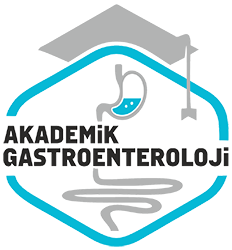Nisan 2022
Gastrointestinal kanamayla taburcu olan hastalarda anemi prevalansi ve klinik yaklasim
Prevalence of anemia and clinical approach in patients discharged after gastrointestinal bleeding
- Ana Sayfa
- Sayılar
- Nisan 2022
- Gastrointestinal kanamayla taburcu olan hastalarda anemi prevalansi ve klinik yaklasim...
Özet
ÖZET • Giriş ve Amaç: Akut gastrointestinal sistem kanamalari siktir. Bu Hastaların taburculuklari sırasında anemi sıklıkla gözlenmektedir. Bu Hastaların hem taburculuk sonrasi izlemi hem de anemi tedavilerine yönelik çalışmalar kisitlidir ve bu konu ile ilgili kilavuzlar bulunmamaktadır. Bu çalışmada akut gastrointestinal sistem kanaması geçiren hastalarda taburcu olurken ve takip eden 3 aylik süreçte anemi prevalansi ve anemiye yaklasim değerlendirilmıştır. Gereç ve Yöntem: Hastanemize Ocak 2017 – Mayis 2018 tarihleri arasında akut gastrointestinal sistem kanamasıyla yatan 197 hasta retrospektif olarak değerlendirilmıştır. Taburculuk sırasında anemi, Dünya Sağlık Örgütü kriterlerine göre, hemoglobin değerinin erkeklerde 13 g/dL, kadınlarda ise 12 g/dL’nin altında olmasi olarak kabul edilmıştır. Bulgular: Akut gastrointestinal sistem kanama nedeniyle hastaneye yatan Hastaların 129’una üst gastrointestinal sistem endoskopi, 3’üne enteroskopi, 45’ine alt gastrointestinal sistem endoskopi, 8’ine üst ve alt gastrointestinal sistem endoskopi, 2’sine üst, orta ve alt gastrointestinal sistem endoskopi uygulanmis, 10 hastaya islem uygulanamamıştır. Hastaların 69’una endoskopik terapötik Girişim yapilmıştır. Hastaların hastanede kalis süresi; 10 ± 13.84 gün iken, yatış sırasında Hastaların %67’sine, ortalama 3.5 ± 5.89 ünite eritrosit süspansiyonu transfüze edilmıştır. Hastaların taburculuk sırasındaki ortalama hemoglobin değeri 9.85 ± 1.67 g/dL’dir. Hastaların %92.4’ünde (kadın %91.1, erkek %93.2, üst gastrointestinal sistem kanama %93.9, orta gastrointestinal sistem kanama %100, alt gastrointestinal sistem kanama %86.8) taburculuk sırasında anemi saptanmıştır. Anemi saptanan Hastaların %9.7’sine taburculuk sırasında demir tedavisi reçete edilmıştır. 197 hastanın %33 kadari taburculuk sonrasi ilk üç ay içerisinde tekrar değerlendirilmis ve bunlarin da %80’inde halen aneminin devam ettigi saptanmıştır. Sonuç: Akut gastrointestinal sistem kanamali hastalar taburcu edilirken anemi orani yüksektir. Çogu hasta anemiye yönelik bir reçete almadan taburcu olmaktadır. Izlemde kontrol başvurulari yetersiz olup, hastalarda anemi devam etmektedir. Bu konuda uygulanacak tedavi ve takibin nasil olmasi gerektigiyle ilgili daha genis sayıli hasta çalışmalarina ve bu konuda görüs birliginin saglandigi kilavuzlara ihtiyaç vardır.
Abstract
ABSTRACT • Background and Aims: Acute gastrointestinal system hemorrhages are frequent, and anemia is frequently seen in patients with acute gastrointestinal system bleeding after hospital discharge. Studies intended for patient follow-ups after discharge and anemia treatment are limited, and this topic has no guidelines. This study aimed to evaluate anemia prevalence and clinical approach in patients with acute gastrointestinal system bleeding after hospital discharge and during 3 months of follow-up. Materials and Method: This study retrospectively evaluated 197 patients with acute gastrointestinal system bleeding who were treated at our hospital between January 2017 and May 2018. Upon discharge, anemia was accepted as hemoglobin levels of < 13 g/dL in men and 12 g/dL in women according to the World Health Organization criteria. Results: Of these patients, 129 underwent upper gastrointestinal endoscopy; 3 enteroscopy; 45 lower gastrointestinal endoscopy; 8 upper and lower gastrointestinal endoscopy; 2 upper, middle, and lower gastrointestinal endoscopies; and 10 did not undergo endoscopy. Additionally, 69 patients underwent therapeutic endoscopic treatments. The mean hospitalization duration was 10 ± 13.84 days, and 67% of patients had erythrocyte transfusion with a mean value of 3.5 ± 5.89 units during hospitalization. The mean hemoglobin rate was 9.85 ± 1.67 g/ dL upon hospital discharge. Of the patients, 92.4% (female: 91.1%, male: 93.2%; upper gastrointestinal bleeding: 93.9%, middle gastrointestinal bleeding: 100%, lower gastrointestinal bleeding: 86.8%) had anemia upon hospital discharge and 9.7% underwent iron deficiency treatment. Of all 197 patients, 33% were evaluated 3 months after discharge from the hospital and 80% of these patients have ongoing anemia. Conclusions: Anemia frequency is high when patients with acute gastrointestinal system bleeding are discharged. Most patients are discharged without receiving a prescription for anemia. In the follow-up, control applications are inadequate and anemia persists in patients. A wider range of patient studies on the treatment application and adherence, as well as guidelines from the consensus body on this issue, is necessary.



